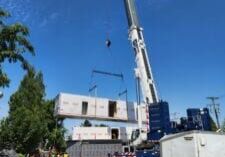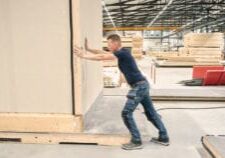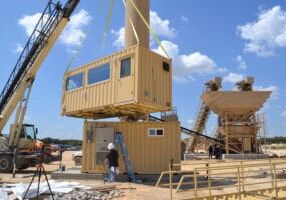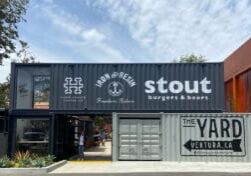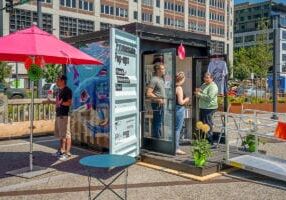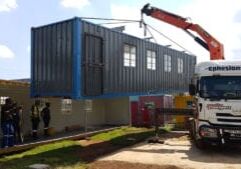Affordable Housing- A Global Issue
MBI was recently asked to participate in an international conference organized by Hong Kong University and hosted by the Construction Industry Council of Hong Kong. The conference centered around Hong Kong’s planned use of “Modular Integrated Construction” (MIC) to address their housing issues.
Hong Kong has one of the highest development  costs in the world, coupled with low land availability, low skilled labor availability, and a large population. Hong Kong is one of the most densely populated countries in the world (ranking fourth behind Singapore) with over 17,348 people per square mile. For comparison, the US ranks 188th with 86 people per square mile and Canada ranks 235th with 10 people per square mile. As a result, Hong Kong ranks as the second most expensive area globally for construction development, behind only New York City.
costs in the world, coupled with low land availability, low skilled labor availability, and a large population. Hong Kong is one of the most densely populated countries in the world (ranking fourth behind Singapore) with over 17,348 people per square mile. For comparison, the US ranks 188th with 86 people per square mile and Canada ranks 235th with 10 people per square mile. As a result, Hong Kong ranks as the second most expensive area globally for construction development, behind only New York City.
Hong Kong has virtually no modular industry today, yet government officials are considering steel modular construction for high-rise buildings to house residents. This is not unprecedented as several presentations during the conference documented progress in other parts of the world. For example, Singapore had no modular industry five years ago, and today four modular public housing projects, each topping 30 stories, have been completed. Five years ago, Australia’s modular industry largely consisted of relocatable buildings and workforce housing. Hickory Group has completed a 43-story building, with a 44-story building about to be complete. While more of a panelized system, this progress towards alternative construction techniques is stunning.
In the U.K. it is estimated that new housing construction needs to double to reach the government’s goal of 300,000 new units annually by the middle of the next decade. The U.K. modular market is much more mature than most other regions, with tall modular structures dating back more than a decade. MBI organized a tour in 2008 to visit U.K. factories as well as a 17-story and 24-story modular student housing projects. Today, 20+ story modular structures are occurring with much more regularity in the U.K.
While there are obviously many differences in overseas markets, there were some striking similarities.
Key Differences
- Hong Kong, Singapore, and the U.K. are smaller geographic areas with limited land availability. As a result, these regions have been forced to adopt high rise construction years ago because they have nowhere to go but “up.”
- Hong Kong, Singapore, U.K., and Australian markets are largely being driven by government agencies to address housing needs.
- There is no modular market whatsoever in Hong Kong now, so there are no preconceived notions about its limitations
Similarities
- Extremely high housing costs
- Low or limited construction labor availability
- Lack of understanding of modular construction from code officials and policy makers.
This article originally appeared in the Modular Advantage Magazine - Third Quarter 2018 released in September 2018.
More from Modular Advantage
AI, Faster Sets, and Automation: The Future of Modular is at World of Modular
While the modular building industry has long known that it can be an effective solution to increase affordable housing, the word is slowly spreading to more mainstream audiences. Three presentations at this year’s World of Modular in Las Vegas hope to provide insight and direction for those seeking a real solution to the crisis.
An Insider’s Guide to the 2025 World of Modular
The Modular Building Institute is bringing its global World of Modular (WOM) event back to Las Vegas, and with it comes some of the industry’s best opportunities for networking, business development, and education. Over the course of the conference’s four days, there will be numerous opportunities for attendees to connect, learn, and leverage event resources to get the most out of the conference.
Affordable Housing Now: The Industry’s Best Bring New Solutions to World of Modular
While the modular building industry has long known that it can be an effective solution to increase affordable housing, the word is slowly spreading to more mainstream audiences. Three presentations at this year’s World of Modular in Las Vegas hope to provide insight and direction for those seeking a real solution to the crisis.
Opportunities for Innovation in Modular Offsite Construction
Modular Offsite Construction has already shattered the myth that it only produces uninspired, box-like designs. Architectural innovations in module geometry, configurations, materials, and products make it possible to create visually stunning buildings without sacrificing functionality or efficiency.
Safe Modular Construction with Aerofilm Air Caster Transport
In collaboration with Aerofilm Systems, Heijmans developed innovative skids using air caster technology for moving modules easily and safely. These pallets are equipped with an auto-flow system, making operation extremely simple.
Miles, Modules, and Memes: Building a Modular Network One Flight at a Time
At the end of the day, social media is just another tool for building connections, and like any other tool, needs to be used skillfully to work properly. Use social media thoughtfully, and it will open doors to real opportunities and relationships you didn’t even see coming.
Falcon Structures: Thinking Inside the Box
Some of Falcon’s latest projects include creating container solutions for New York’s Central Park and an East Coast professional baseball team. More and more, Falcon is shipping out container bathrooms and locker rooms to improve traditionally difficult work environments, like those in oil and gas or construction.
UrbanBloc—From Passion to Industry Leader
UrbanBloc specializes in three main categories or markets – what they call “Phase 0” projects, amenities, and urban infill. Clients are often attracted to shipping containers because from a real estate perspective they are considered an asset. Having the flexibility to move and transport these assets allows owners to respond to different circumstances in a fluid manner that they can’t get with standard construction.
The Hospitality Game-Changer
“Hospitality is about more than just providing a service – it’s about delivering an experience,” says Anthony Halsch, CEO of ROXBOX. “And that’s where containers thrive. They allow us to create spaces that are unique, efficient, and sustainable.”
Container Conversions Counts on Simplicity to Provide Critical Solutions
Container Conversions has fabricated and developed thousands of containers for varied projects, including rental refrigeration options, offices, kitchens, temporary workplace housing, and mobile health clinics.



